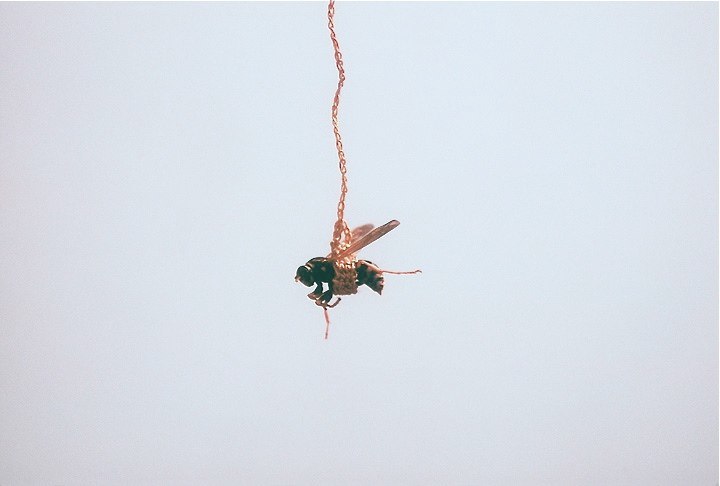LAWRENCE LABIANCA & ESTHER TRAUGOT
AUGUST 6TH-SEPTEMBER 18TH, 2010
Esther Traugot Forty-two Wasps, detail 2010 dead wasps, thread approx. 104 x 78.5 x 102 inches
Nature is a strong influence in the work of Lawrence LaBianca and Esther Traugot. LaBianca’s part-time upbringing in rural Maine and Traugot’s family agricultural business have brought them into close and extended contact with the natural world in a way that is becoming more rare among average Americans.What they have taken away from those experiences are like two ends of the spectrum of humankind’s relationship with nature.
LaBianca’s current body of work is largely inspired by Herman Melville’s Moby-Dick, which the artist has referenced in previous works. One of the primary themes of Moby-Dick is the awesome power of nature, represented by a whale, which is beyond the control of human beings. As in the American Romantic novel, boat forms, water, suggested allegory and dream-like visions pervade several of LaBianca’s sculptures.A boat is a suggestive image, sometimes personifying man within life’s passage, and other times providing a means for man to venture out into nature by traversing the seas.The sculpture entitled Dream invites interpretation with its simplified rusted steel boat upside-down and raised up on a stand, under which is an ethereal projection simulating water. In And Meet It Is, two glass boat silhouettes are in the path of head-on collision on an arc of steel, perhaps suggesting unavoidable and unforeseen danger, or fate that brings two souls together. Water figures as a strong and brutal force in Boat House, a series of cast glass houses that appear corroded almost beyond recognition, as well as in Revelation, in which beautiful script transposed onto copper is nearly washed away by patinas.
While LaBianca seems concerned with the power of nature and the challenge it poses to man,Traugot envisions nature in a way that is vulnerable. In her sculptures and installations, natural forms appear in need and deserving of human attention, nurturing and preservation. In all her works in the exhibition, crocheted gold-colored thread or yarn wraps snugly around twigs, branches, rocks or insects, as though providing protective cover. This wrapping references the gilding of precious objects, bandages and hand-knit cozies or pet sweaters.The immediate enchanting quality of the beautiful color and expert execution of the stitches is offset by the foreboding quality of dismembered tree parts and dead wasps encased by them. Interaction with the surrounding space is also a significant factor in Traugot’s work. In Stubs, cut pieces of branches protrude directly from the wall like a vertical truncated forest. Fixed is a spindly branch suspended from the ceiling from its own gold wrapping, as though in traction. In Forty-two Wasps, a mass of dead insects hangs from strands of their individual crocheted harnesses, creating a rain-like gold veil.
With their dichotomous perspectives, both artists venerate nature and its human significance. Traugot’s vision of a fragile environment echoes contemporary concerns about man’s degradation of the planet. LaBianca, meanwhile, reminds us of a view of nature that has a longer history, that of its sublime power, daunting challenges and potential to reveal the secrets of existence.























